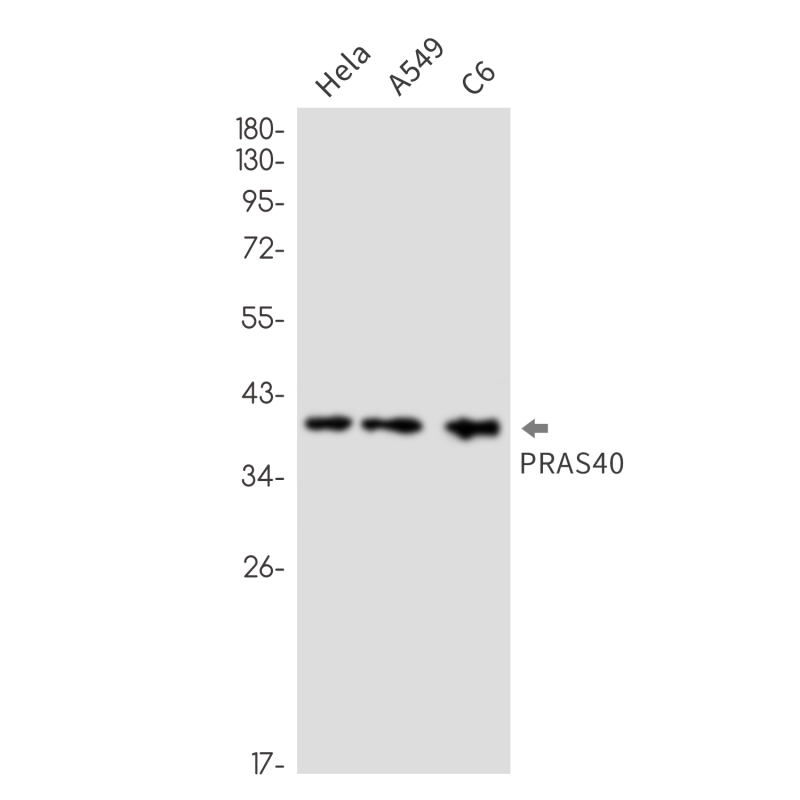
| WB | 1/500-1/1000 | Human,Mouse,Rat |
| IF | 1/20 | Human,Mouse,Rat |
| IHC | 咨询技术 | Human,Mouse,Rat |
| ICC | 技术咨询 | Human,Mouse,Rat |
| FCM | 咨询技术 | Human,Mouse,Rat |
| Elisa | 咨询技术 | Human,Mouse,Rat |
| Aliases | AKT1S1; PRAS40; Proline-rich AKT1 substrate 1; 40 kDa proline-rich AKT substrate |
| Entrez GeneID | 84335 |
| WB Predicted band size | Calculated MW: 27 kDa; Observed MW: 40 kDa |
| Host/Isotype | Rabbit IgG |
| Antibody Type | Primary antibody |
| Storage | Store at 4°C short term. Aliquot and store at -20°C long term. Avoid freeze/thaw cycles. |
| Species Reactivity | Human,Rat |
| Immunogen | A synthetic peptide of human PRAS40 |
| Formulation | Purified antibody in TBS with 0.05% sodium azide,0.05%BSA and 50% glycerol. |
+ +
以下是关于PRAS40抗体的3篇参考文献及其简要摘要:
1. **文献名称**:*PRAS40 regulates mTORC1 kinase activity by functioning as a direct inhibitor of substrate binding*
**作者**:Sancak Y, et al.
**摘要**:该研究通过使用PRAS40特异性抗体进行免疫共沉淀和Western blot分析,揭示了PRAS40通过直接结合mTORC1复合物抑制其底物识别,从而调控细胞生长和代谢的分子机制。
2. **文献名称**:*Insulin stimulates site-specific phosphorylation of the PRAS40 inhibitor of mTORC1 in adipocytes*
**作者**:Wang L, Rhodes CJ.
**摘要**:本文利用PRAS40抗体及磷酸化特异性抗体,证明胰岛素通过Akt信号通路诱导PRAS40特定位点的磷酸化,解除其对mTORC1的抑制,促进脂肪细胞营养摄取与代谢。
3. **文献名称**:*PRAS40 is a target for degradation in response to TNFα-induced apoptosis*
**作者**:Madhunapantula SV, et al.
**摘要**:研究通过Western blot和免疫荧光技术,发现肿瘤坏死因子α(TNFα)通过蛋白酶体途径降解PRAS40.导致mTORC1活性异常,进而促进癌细胞凋亡。
这些文献均通过PRAS40抗体探究其在信号转导、代谢调控及疾病中的作用,涵盖功能机制与病理相关性。
PRAS40 (Proline-Rich Akt Substrate of 40 kDa), also known as AKT1S1. is a regulatory component of the mTORC1 (mechanistic target of rapamycin complex 1) signaling pathway, which plays a central role in cell growth, proliferation, and metabolism. Discovered as a direct substrate of Akt (protein kinase B), PRAS40 functions as an inhibitor of mTORC1 by binding to its core component, Raptor, under nutrient-deprived conditions. Phosphorylation of PRAS40 by Akt or other kinases (e.g., mTOR itself) disrupts this interaction, relieving mTORC1 inhibition and promoting downstream signaling. This dynamic regulation links PRAS40 to cellular responses to growth factors, energy status, and stress.
PRAS40 antibodies are essential tools for studying its expression, phosphorylation status (e.g., at Thr246 or Ser183/221 residues), and interactions in various biological contexts. These antibodies are widely used in techniques like Western blotting, immunoprecipitation, and immunofluorescence to explore PRAS40’s role in cancer, diabetes, and neurodegenerative diseases. Dysregulation of PRAS40 has been implicated in tumorigenesis, as its phosphorylation often correlates with mTORC1 hyperactivation in cancers such as breast and prostate cancer. Additionally, PRAS40 is linked to insulin resistance and Alzheimer’s pathology, making it a potential therapeutic target. Validated antibodies specific to PRAS40 or its phosphorylated forms help elucidate its regulatory mechanisms and disease associations, advancing both basic and translational research.
×